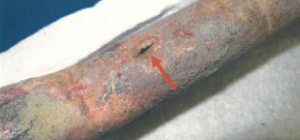Pinholes in Pipes Lead to Water Damage – Part 2 of 2
In Part 1 of this article relating to pinholes in pipes Dr. Vardi discussed the common elements associated with defective installation of copper water lines. In Part 2 the emphasis will be on the conditions that exist primarily below ground, out of sight, and are often not considered.
In the their August 1984 American Water Works Association Journal article “Conditions Contributing to Underground Copper Corrosion,” James R. Myers and Arthur Cohen provide insight into the use of copper pipe and conditions that lead to pipe failure. The authors point out that “copper pipes used to convey water in Egypt nearly 5000 years ago are still in existence.” The authors further state that “copper is one of the few metals that exists as an element in its natural form.” How then can this enduring and pure metal fail? What are the conditions that lead to failure? Dr. Vardi, as a construction expert witness who is often hired to investigate and report on a variety of issues, has observed the following seven common conditions also noted by the authors above including:
• Abnormally aggressive soils
• Localized and long-line-type concentration cells created by differences in soil composition
• The action of stray direct currents (DC) flowing in the ground
• Faulty design and workmanship (workmanship issues were covered in Part 1 of 2)
• Certain conditions created by alternating currents (AC)
• Thermogalvanic effects
• Galvanic action involving dissimilar materials
The most commonly found condition in Dr. Vardi’s inspections is “galvanic action involving dissimilar materials” which is often the result of defective installation. That specific condition is caused when copper pipes are in contact with steel pipes, steel straps, steel wires, etc. Copper does not rust the way steel pipes do; in fact, copper never rusts, it corrodes. The corrosion which people often refer to as the patina is also called verdigris. It creates a protective layer for the copper. Steel on the other hand will rust and eventually break down. In some cases the breakdown of the steel can lead to major problems including broken water lines and structural failures. In the 1980s the Statue of Liberty had to undergo major restoration because the original framework for her exterior cladding was made of steel. Over the years the galvanic action due to electrolysis eroded both the cladding and the steel framework.
In addition, as noted by the authors, galvanic action can also occur because copper embedded in concrete is “normally cathodic to nearby copper that is exposed to soil.” This condition leads to a “subtle form of galvanic corrosion [that] can cause deterioration of copper exposed to the soil in the immediate vicinity of the soil-concrete interface.” Apparently, this form of below ground galvanic action is more common to Southern California and may require “complete concrete encasement of copper water tubes.”
The next most common condition found by Dr. Vardi is thermogalvanic effects. Myers and Cohen describe this condition as being created “by temperature differences in under-the-slab, hot and cold domestic water lines that are in metallic contact with each other at the hot-water heater.” They further state that “This phenomenon should be suspected when the external corrosion of copper water lines occurs only to the hot-water tubes.” Then they explain that “Thermal effects in the immediate vicinity of underground hot-water tubes can sometimes aggravate the corrosion problem by concentrating salts at these locations through the evaporation of water that might be draining through the soil.” Most often the initial attack on these copper pipes is on the exterior of the copper eventually leading to the corrosion and pitting of the pipes. It seems too easy but all it takes to reduce the chance of catastrophic failure of copper pipes is to simply wrap the pipes with protective tape.
One of the cases investigated by Dr. Vardi was copper pipe failure in a brand new home located in the hills above Pasadena, CA. The homeowner reported a claim to his insurance company stating that a pipe broke beneath the concrete slab causing extensive damage to his hardwood floor. The house was built on conventional area soil and followed normal practice of having a slabon- grade first floor. Hot and cold copper piping was installed beneath the slab eventually terminating at the hot water tank served by a recirculation pump.
Dr. Vardi was able to examine the area beneath the concrete slab before it was repaired and found that the hot and cold water lines were within inches of each other. The damaged pipes were also examined and found to have pinholes and markings of corrosion on their exteriors and visible thinning of the pipe walls. The damaged pipe was then sent to Vollmer Gray Engineering Laboratories, Inc. for detailed review.  Vollmer Gray concluded that the “thinning of the pipe is due to soil side corrosion . Hot water pipes that are electrically continuous with and in close proximity to the cold water piping in soil can form a galvanic corrosion cell in which the hot water pipe becomes the sacrificial anode and the cold water pipe becomes the protected cathode. The soil itself may be a contributing factor if high levels of ammonium chlorides, nitrates and sulfates are present.”
Vollmer Gray concluded that the “thinning of the pipe is due to soil side corrosion . Hot water pipes that are electrically continuous with and in close proximity to the cold water piping in soil can form a galvanic corrosion cell in which the hot water pipe becomes the sacrificial anode and the cold water pipe becomes the protected cathode. The soil itself may be a contributing factor if high levels of ammonium chlorides, nitrates and sulfates are present.”
It turned out that the pipe was not busted but was suffering from pinholes which caused the problems reported by the homeowner. The pipe was repaired and the plumber doing the repair wrapped the new section of hot water line with a protective tape to prevent future failure at the location. Of course, Dr. Vardi advised the homeowner that there is no guarantee that other portions of the piping were not already damaged or could be damaged in the future.
There are certain precautions that can be implemented.One of the first steps is to review the pre-construction soil report to determine if the soil has excess amounts of ammonium and sulfates. Black corrosion on the external surface of copper pipes such as the one in this case is one sign of potential soil issues.
As for issues concerning the action of stray direct currents (DC) flowing in the ground and certain conditions created by alternating currents (AC) those are more complicated and less frequent occurrences that are beyond the scope of an article such as this one. A full review of the August 1984, American Water Works Association Journal article titled Conditions Contributing to Underground Copper Corrosion, by James R. Myers and Arthur Cohen is available for free on the internet.
As a construction expert witness Dr. Vardi relies on his 40 years of experience to determine what causes the failure of various building components. Equally important is knowing when to call in other experts to assist such as the Vollmer Gray Laboratories near Long Beach, CA. It takes a team of experts to resolve complicated problems. The cumulative knowledge of XL Services’ team and associates enjoys doing that every day for our clients.
You can review the first part of this article here

